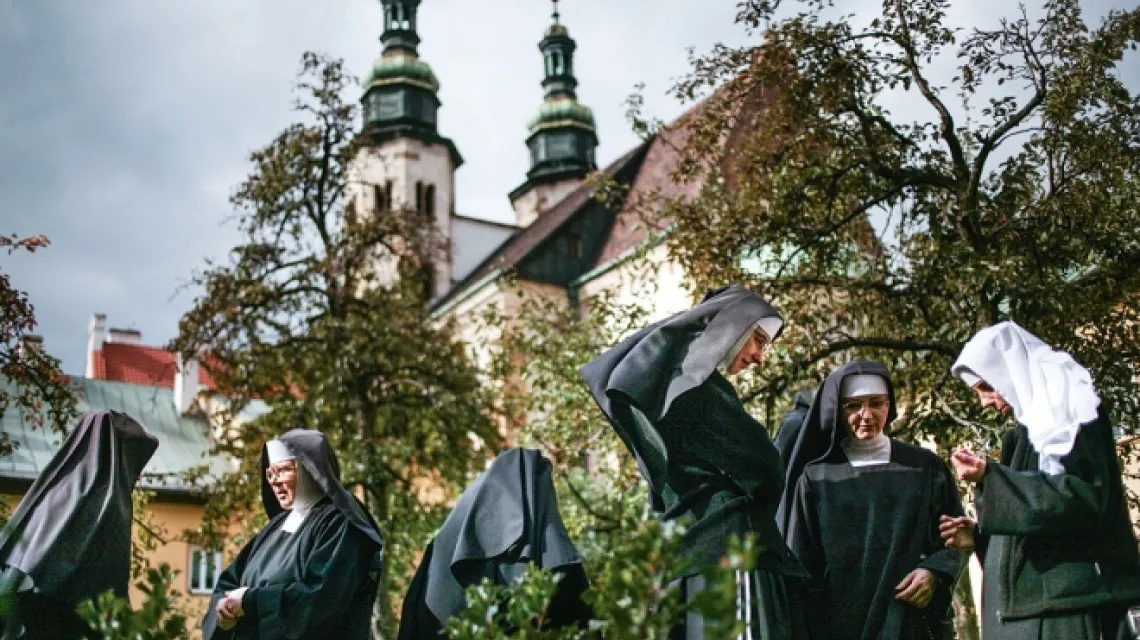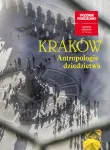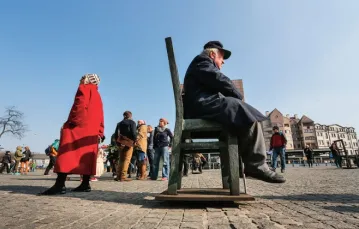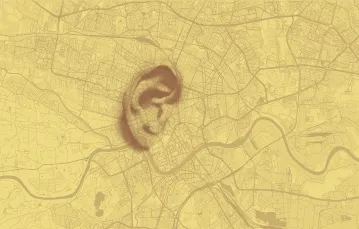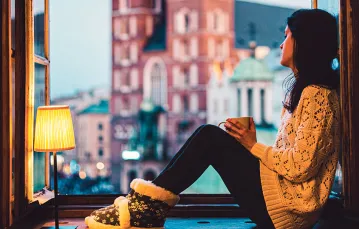Wykupienie dostępu pozwoli Ci czytać artykuły wysokiej jakości i wspierać niezależne dziennikarstwo w wymagających dla wydawców czasach. Rośnij z nami! Pełna oferta →
ANNA NIEDŹWIEDŹ: You conducted ethnographic research on Grodzka Street, which provided the basis for part of our “City Maps” exhibition. What kind of street did you discover?
Alicja Baczyńska-Hryhorowicz: I never liked Grodzka; I always associated it with hubbub and crowds of tourists. When I was a student, I had to brave the crowds to get to class. The 2017 survey allowed me to see the street from a different angle, not just as a tourist route. I saw its intimacy. I guess I always knew that somebody lived in those houses, but it was only at the beginning of my research, when I went for an evening walk along Grodzka, that I noticed signs of private life – lights in the windows, curtains, flowers. That was my first discovery.
Bartosz Arkuszewski: For me, the street used to be transparent. Like Alicja, I attended lectures there and treated it instrumentally, as a route I had to follow in order to reach my destination. The street itself meant nothing to me. During our research, I heard people’s recollections and discovered what Grodzka meant for particular people. Someone got married there, someone has fond memories, and someone works there. A new dimension of space has emerged.
Alicja Soćko-Mucha: At first, it was difficult to look at this space carefully. Previously, I considered the street to be just pretty. I thought it was an elegant part of the city, worth showing to people who came to visit me in Kraków. And, of course, I associated it with tourists – especially in summer or on Sundays.
How did a noisy, touristy, all-too-familiar street in the centre of the city unveil its intimate side?
KAJA KAJDER: I remember one poignant moment. I went to conduct an ethnographic interview with a family who lived on the first floor of a tenement house, with windows overlooking the noisy street. They were happy to live in a place like this –it was their dream come true. Knowing that I was coming, they invited their next door neighbour. During our interview, I realised that there was a strong bond between neighbours in Grodzka Street. People know one another’s faces and are sometimes very close. This never occurred to me this before, perhaps because I knew Grodzka primarily as a place where we meet others in passing, while on the move. We might be familiar with some of the permanent characters such as bagel sellers, buskers, street artists or the people who distribute leaflets.
Meanwhile, a community based on strong neighbourly ties still exists there, although it is now disappearing. Grodzka is undergoing gentrification. There are more and more bars, restaurants, and accommodation – short-term rentals. Fewer and fewer people and an increasing number of hotels. And as we spoke in this beautiful old apartment, with windows open onto the street from which the muffled noise from below reached us, my hosts started to point to windows on the other side of Grodzka, specific floors of other tenement houses: “Oh, X used to live there, and Y lived there… Now it’s a short-term rental apartment; and over there, the windows have been dark for a long time, so they’ve probably moved out”. And then I felt sad.
ASM: One of my interlocutors told me that the tenement houses were dying, and that this was very sad because long-time residents were moving out.
How can tenement houses be dying when more and more buildings on Grodzka Street have shiny, renovated façades?
ABH: The same motif recurred in conversations with shop assistants who had been working on the street for many years. They told me that it used to have many more shops, ordinary ones, for everyday shopping. For instance, there was a butcher.
BA: In the residents’ memories, Grodzka appears to be a living space. My older interlocutors were able to accurately reconstruct all those shops, one by one, on both sides of the street. They remembered how cars used to drive along the street, which is now almost completely pedestrianised. But this life still goes on. Aside from tourists, there are courtyards, apartments, university buildings, parishes where community life continues, people work here, and there is a convent, which is also a house, after all.
In Grodzka, walking from plac Wszystkich Świętych (All Saints’ Square), we encounter this amazing cluster on the eastern side. First we pass a former Jewish house of prayer, and then, slightly further on, literally in a line: the spectacular Church of SS Peter and Paul, the Poor Clares Convent, and the Evangelical church and parish just beyond them.
ASM: During my research, I focused on the Poor Clares who reside in Grodzka. Their convent looks somewhat extraterritorial. The gate, bars, windows, and walls serve as the physical boundaries of the enclosure, which the researcher will probably never be able to enter. The adjoining Church of St Andrew feels intimate. You have to go down a few steps to enter it; it’s quiet, rather dark, and cool in summer. I have a feeling that even the tourists I encountered there were quieter than, for instance, those in St Mary's Church in the Market Square or in the Church of SS Peter and Paul, which stands right next to it.
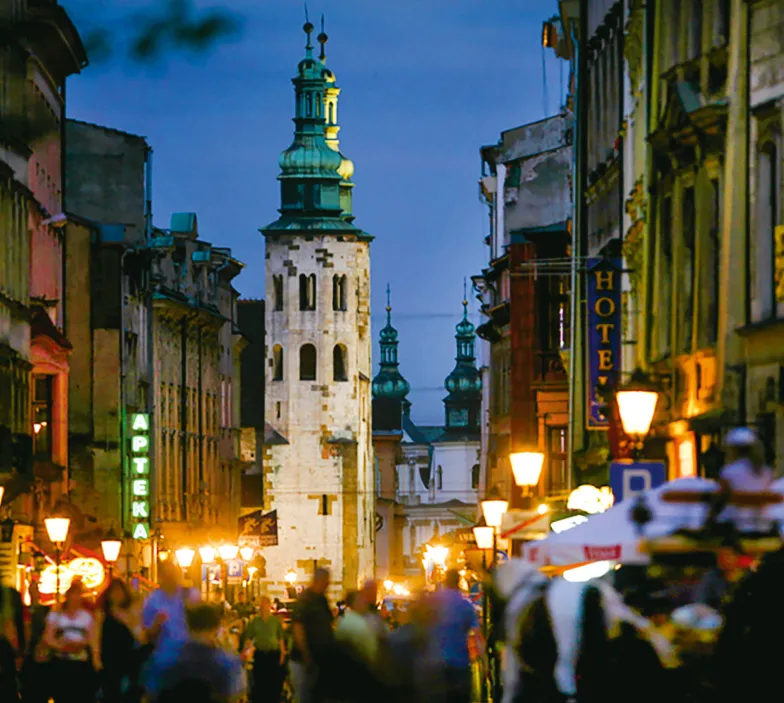
And the convent itself?
ASM: The nuns emphasised that it was their home, that they tried to embellish it, and that each successive generation has added something. They also said that the street sounds could be heard inside the convent, and that they treated them as a call to pray for those whose steps or voices they heard. Some neighbours, in turn, recalled the loud barking of a dog that once belonged to the nuns, while older residents of Grodzka even remembered a cow that they used to keep near the convent.
These are first-hand memories from several decades ago, but we no longer associate such stories either with the life of Grodzka Street or with the enclosed order of Poor Clares. The convent has been there for centuries and it brings an element of ordinary, everyday life to the area.
A landmark which astonished visitors to the exhibition was another place of religious worship – the Mordechaj Tigner Synagogue. Many people did not associate Grodzka Street with a Jewish house of prayer.
KK: This space is hidden in an annexe, in the courtyard behind house Nos 28 and 30. When we conducted our research, the gate leading to the courtyard was already closed. Today, there is a souvenir shop in the hallway, which blocks access to it. It is difficult to say what fate awaits the remnants of this synagogue and what its current condition is.
At the exhibition we showed an image of this place based on photographs and the recollections of people who were able to visit it years ago. Photographs from a few years back showed an abandoned, ruined building, but with a still impressive 1930s glass roof.
One of the residents of Grodzka described the house of prayer as a place that “is, but does not exist”.
KK: There is no plaque on the tenement house recalling the history of the annexe. The general public does not know about this house of prayer. Only sometimes do guides stop here to mention the “synagogue on Grodzka Street” to their groups. Some visitors from Israel or from the United States are aware of its presence. I found an Israeli travel guide in which the place is mentioned. However, people usually associate the city’s Jewish past with Kazimierz, then Oskar Schindler’s factory, and not much else. Only those who are interested in the history of Kraków’s Jews remember Tigner’s house of prayer.
And the existence of this space in the city centre would serve as a reminder that Jewish life was not limited to Kazimierz. Of course, you can go back to the Middle Ages and the former ulica Żydowska (Jewish Street), nowadays św. Anny (St Anne’s Street). Significantly, however, Tigner’s house of prayer dates back to the beginning of the 20th century. It is a modernist building and cannot be categorised as belonging to a distant past. Today, when speaking of Kraków's Jewish past, we like to return to the interwar period. It is puzzling that this place is not mentioned in those narratives. After all, it proves that Jews were present in the city centre, that they lived and had their shops and houses of prayer here.
Buildings narrate the history of the religious communities associated with them.
ABH: This was also what we tried to show in connection with the Lutheran parish. St Martin’s Church, which is adjacent to the Poor Clares, was originally built for the Carmelite nuns but has been the seat of the Evangelical parish for more than 200 years. It is the only Evangelical parish in Kraków and is strongly rooted in this particular place. The congregation includes many generations of people – it is a place which is ever-present in the life of many Evangelical families, a place where the community comes together. When I interviewed them, I felt that I had found a community which was very close-knit and aware of its separate identity, but also open to others.
In the parish museum, the itinerant history of the parish is told through its seals – the oldest one being from the 16th century, another from the period after the church had been burned down and the community had left Kraków, still another from the Podgórze district, and finally seals from the new seat in Grodzka Street.
ABH: The fact that the Evangelical community cares a lot about its history is evident even in the arrangement of the space in parish buildings. In the courtyard and hallways, epitaphs and stone tablets are displayed alongside maps, framed documents, and paintings. This is another enclave in Grodzka. There is a residential quarter here, a school, and a religious education room. Tourists rarely pay much attention to St Martin’s Church. It is slightly set back from the street, fenced off, and seems to melt into its surroundings, because right next to it are competitors in the form of two eye-catching churches.
There are the two striking towers of St Andrew's Church and, of course, the adjacent Church of SS Peter and Paul, which sports a dome, façade, and stairs, and a fence crowned with statues of the Apostles. During our survey, some interviewees described it as a miniature Italy in Kraków.
BA: It’s a gigantic post-Jesuit church that imitates Roman models. Today it is the most touristy place on the whole street. Nevertheless, we should remember that the church has a very complicated history. It remains like a palimpsest – with multiple layers and things to be uncovered. There are tourists, there is a church, and there is also the recently created National Pantheon, which is a place associated with memory, but at the same time a curiosity and a tourist attraction. There is also a Roman Catholic parish, but a peculiar one, since it was originally associated with the no longer extant Church of All Saints.
This is an extraordinary space. You could say that a tourist or passer-by is handed a box with a deck of cards, but then needs to open this box and look at each of the cards separately. The same could essentially be said of all of Grodzka Street. ©
Interview by ANNA NIEDŹWIEDŹ
KRAKÓW. ANTROPOLOGIE DZIEDZICTWA – CZYTAJ CAŁY DODATEK SPECJALNY >>>
KRAKOW. ANTHROPOLOGIES OF HERITAGE – READ MORE IN ENGLISH >>>

